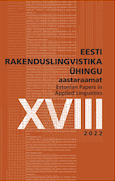JUHTUMIANALÜÜS: MÄRKAMATU KEELEÕPPE PROJEKT TLÜ-S
UNNOTICEABLE LANGUAGE TEACHING
Author(s): Tiina Rüütmaa, Merilin AruveeSubject(s): Education, Foreign languages learning, Applied Linguistics, Finno-Ugrian studies
Published by: Eesti Rakenduslingvistika Ühing (ERÜ)
Keywords: Estonian as second language; non-formal language learning; task-based language learning; CLIL; hobby education;
Summary/Abstract: Since 2015 Estonia’s immigration balance has been positive. That has brought along increased variety in L2 learners and a need for innovative approaches to L2 teaching. Little attention has been paid to the language learner’s opportunities to develop their language skills in the authentic environment: according to learners, native speakers tend to change the language to the common lingua franca instead of supporting them. The article gives an overview of a case study of an unnoticeable language teaching project that was carried out within an interdisciplinary project course at Tallinn University where students from various disciplines participated together. The main objectives of the project were to propagate innovative language teaching methods and opportunities for non-formal learning, but also to develop a new language teaching style and to increase native speakers’ consciousness of their role in supporting learners and to support integration. The study is based on self-reflections of both students and project leaders and aims to find out what unnoticeable language teaching requires from organisers of activities and how participants defined this approach at the end of the project. Most students became considerably more aware of innovative language teaching methods and their effectiveness. The project was particularly useful for those who could use their new skills in their work (teachers, coaches etc.), but others found it beneficial as well. Nevertheless, it became obvious that the integration-related goals should be better emphasized throughout the course: these were seldom mentioned in the self-reflections. Students should also be referred to cogitate upon how they could use their new skills when communicating with non-Estonian speakers. Native Estonian speakers should realise their responsibility in supporting learners and recognising themselves as an authentic language resource. Though it was not often explicitly expressed, the self-reflections indicated that our projects’ participants will not be as eager to change language as before. The practical outcome of the project could be a non-formal or in-service program for educationalists. We hope the project spreads awareness of a simple way of fostering integration and supporting language learners – how to be an unnoticeable language teacher. The latter of course does not mean there will be no need for professional E2 teachers; we hope our project has shown how exciting and useful the profession can be and that such courses will attract more people to take up teacher training in the future.
Journal: Eesti Rakenduslingvistika Ühingu aastaraamat
- Issue Year: 2022
- Issue No: 18
- Page Range: 245-261
- Page Count: 17
- Language: Estonian

